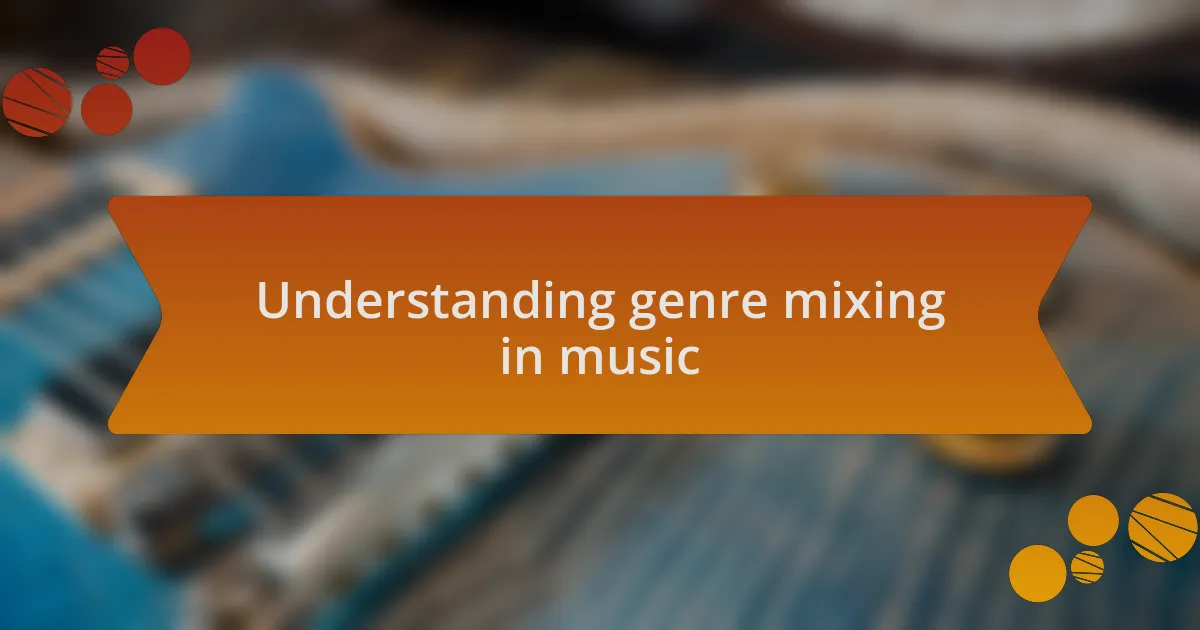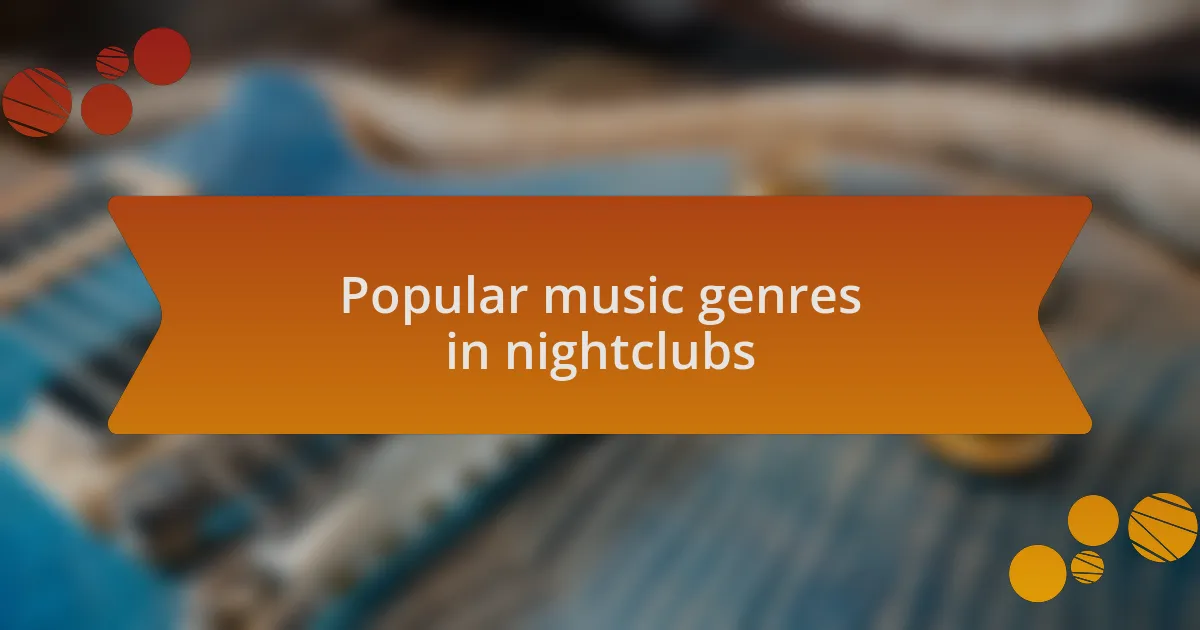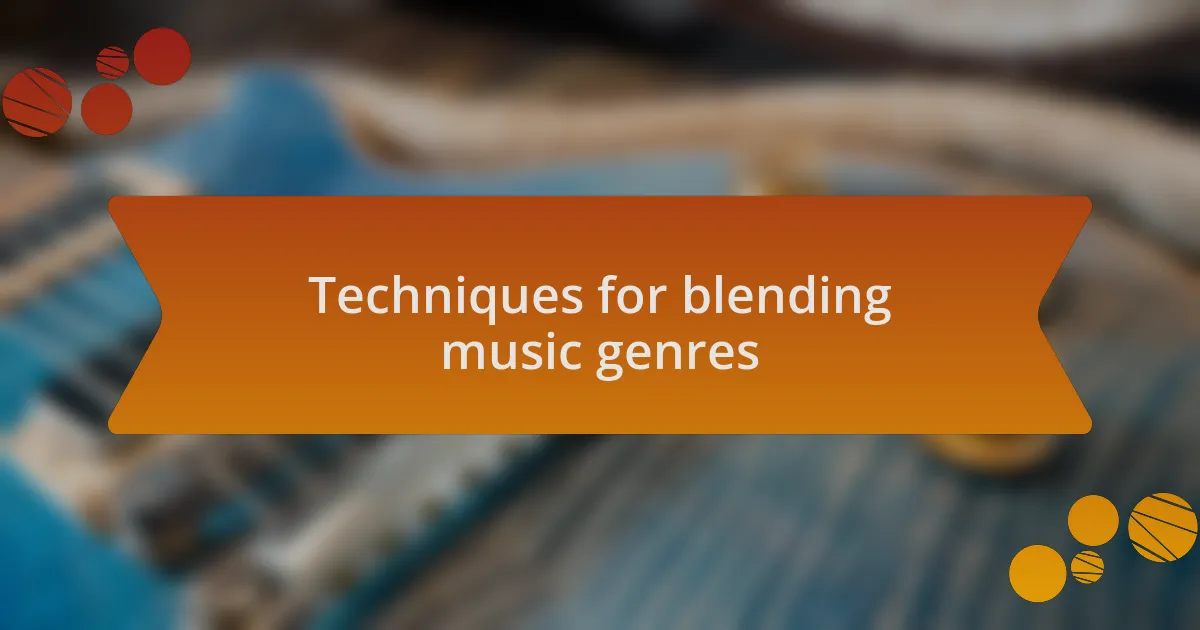Key takeaways:
- Genre mixing in music creates unique emotional connections, blending nostalgia with modern elements.
- Nightclubs thrive on high-energy genres like house, techno, reggaeton, and trap, which enhance the atmosphere and engage patrons.
- Techniques for blending genres include layering sounds, adjusting tempos, and incorporating familiar hooks to foster audience connection.
- A unique nightclub atmosphere is shaped by sensory experiences, soundscapes, and crowd interaction, enhancing the sense of community and enjoyment.

Understanding genre mixing in music
Genre mixing in music is like blending flavors in a signature cocktail; each element adds its unique taste but, when combined thoughtfully, creates something entirely new and exciting. I remember the first time I heard a track that seamlessly wove together hip-hop beats with jazz elements. It was a revelation—it felt like two worlds colliding and dancing together, breathing new life into both genres.
When artists experiment with genre mixing, they often tap into a deeper emotional connection with their audience. Have you ever experienced a song that brought back memories from a specific time in your life, but it also felt fresh because of its modern twist? That’s the beauty of genre fusion; it can evoke nostalgia while keeping the listener engaged in the present moment.
Genre mixing also allows for broader storytelling. For instance, blending country with electronic music can capture the struggles and joys of life in both a relatable and contemporary way. In my experience, when I hear these creative combinations, it feels as though I’m being invited to a new kind of narrative—a journey that reflects varied experiences, emotions, and cultures all at once.

Popular music genres in nightclubs
Nightclubs thrive on energy, and the genres that dominate their playlists play a massive role in creating that atmosphere. House music, with its pulsating beats and hypnotic melodies, often sets the stage for unforgettable nights. I recall a time when I stepped onto a dance floor filled with vibrant lights, and the DJ seamlessly transitioned from a deep house track into a lively techno anthem. It felt like an electric current coursed through the crowd, uniting everyone in that moment.
While house and techno are staples, I’ve noticed an exciting surge in the popularity of genres like reggaeton and trap in nightlife settings. These styles bring infectious rhythms that compel you to move. I remember being at a club where the DJ dropped a reggaeton remix of a classic pop song. Instantly, the mood shifted—people who were once casually chatting suddenly turned into a sea of dancers, singing along and celebrating the fusion of cultures and sounds.
Then there’s the undeniable allure of funk and disco, which have made a comeback in nightlife lately. The other night, I found myself dancing to a funky groove that intertwined live instrumentation with electronic elements. It reminded me how powerful music can be; it can transport you to different eras and evoke a sense of joy that transcends time. Isn’t it fascinating how each genre, whether it’s EDM, hip-hop, or disco, brings its own flair to the nightclub experience, inviting everyone to join in the celebration?

Techniques for blending music genres
Mixing genres can be an art form, and one effective technique is to layer different elements from each genre to create a unique sound. I remember a night at a club where the DJ melded deep house beats with jazz-inspired saxophone riffs. The blend was mesmerizing—it felt like listening to a conversation between two different worlds, with each genre complementing the other in unexpected ways.
Another powerful method is to play with tempo and rhythm, adjusting the pace to maintain energy while introducing contrasting styles. I was at a festival once where a DJ dropped a fast-paced trap track and then seamlessly slowed it down to a funky disco groove. The crowd’s reaction was instant; the shift in rhythm sparked a dance-off that brought the entire audience together, proving that a thoughtful change in tempo can elevate the experience.
Finally, consider using familiar hooks from popular songs across genres to create an instant connection. One time, I heard a mashup that featured a well-known pop chorus layered over a hip-hop beat. It was captivating to see the crowd engage with both the nostalgia of the familiar lyrics and the new, vibrant rhythm. This technique not only ignites excitement but also fosters a shared experience among diverse audiences—something every DJ aims to achieve.

Creating a unique nightclub atmosphere
Creating a unique nightclub atmosphere often hinges on the sensory experiences that immerse attendees in the vibe of the night. I recall stepping into a venue where the entire space was transformed by soft, atmospheric lighting that pulsed with the beat, casting shadows that danced on the walls. This not only set a mood but made each person feel like a part of the unfolding story—how could you not want to lose yourself on the dance floor in such an inviting environment?
Soundscapes play a crucial role in this creation, too. One of my favorite nights happened when a DJ incorporated unexpected sounds—think of the murmurs of a bustling city or gentle waves crashing—woven into the tracks. It was as if we were taken on a sonic journey through different realms, every beat grounding us to the dance floor while our imaginations soared. Isn’t it incredible how sound and ambiance can electrify the atmosphere and forge unforgettable memories?
Don’t underestimate the impact of crowd interaction, either. I once attended a show where the DJ encouraged periodic shout-outs, inviting attendees to respond and engage with the music. It created a sense of community that lifted the energy in the room and made everyone feel connected. Why is that? Perhaps it’s the simple, primal joy of shared rhythm and collective experience that truly defines a unique nightclub atmosphere.